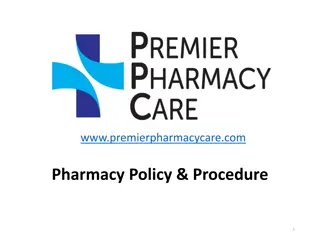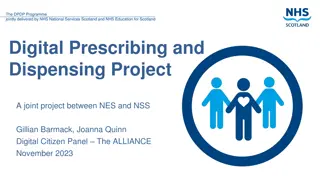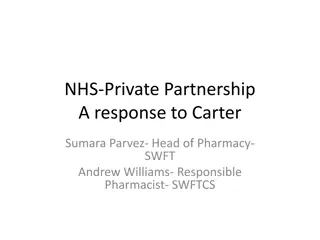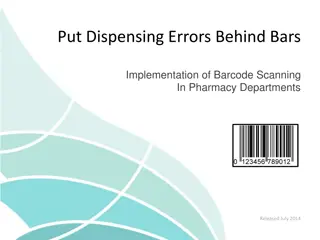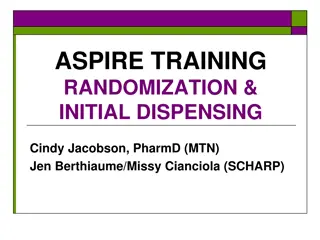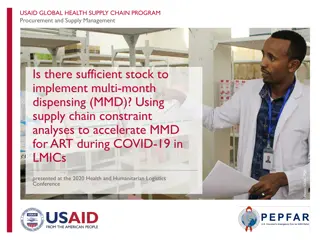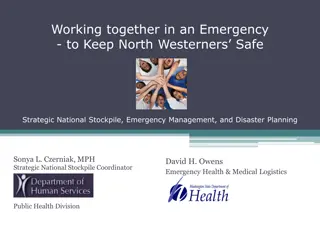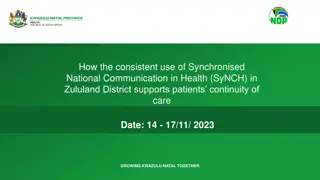Strategic National Stockpile and Points of Dispensing
The Strategic National Stockpile (SNS) is a crucial asset in the federal government's medical response infrastructure, providing essential medical supplies during emergencies. Inventory Management and Tracking System (IMATS) helps in managing and tracking distribution paths of medical resources. Points of Dispensing (PODs) are centralized locations where the public can access life-sustaining commodities following disasters. Synergy between SNS and PODs is vital in fueling POD systems during mass casualty events, with a focus on information sharing and distribution for effective supply chain management.
Download Presentation

Please find below an Image/Link to download the presentation.
The content on the website is provided AS IS for your information and personal use only. It may not be sold, licensed, or shared on other websites without obtaining consent from the author.If you encounter any issues during the download, it is possible that the publisher has removed the file from their server.
You are allowed to download the files provided on this website for personal or commercial use, subject to the condition that they are used lawfully. All files are the property of their respective owners.
The content on the website is provided AS IS for your information and personal use only. It may not be sold, licensed, or shared on other websites without obtaining consent from the author.
E N D
Presentation Transcript
Strategic National Stockpile and Points of Dispensing MODULE 4 SECTION
Strategic National Stockpile This is an asset in the medical response infrastructure of the federal government. It can be used as a short term solution to medical supply chain gaps for state governments by providing communities with critical types of equipment (CDC, 2021). KEY POINTS SNS PRODUCTS AND SUPPLIES Large quantities of medical resources can be accessed through the SNS, to include: Ventilators PPE Pharmaceutical supplies Federal Medical Stations (Treatment Facilities) INVENTORY MANAGEMENT AND TRACKING SYSTEM (IMATS) This is a tool used by federal, state, and local responders to keep track of the distribution paths of medical supplies. As a digital tool, IMATS can be used to generate records of local inventories, so that operators can make informed decisions about what orders to submit for restocking. (CDC, 2021; HHS, 2021)
Points of Dispensing (PODS) PODs are centralized locations where the public picks up life sustaining commodities following a disaster or emergency, including shelf-stable food and water. (FEMA, 2009). KEY POINTS WHEN ARE PODS USED? A community typically begins to activate POD systems as a result of a mass casualty event that causes a need for widespread medical care. This can include a natural disaster, infectious diseases outbreak, or terrorist attack. The U.S. Centers for Disease Control and Prevention considers PODs to be a default tool for prophylaxis distribution following a biological agent threat. COMMON FUNCTIONS OF PODS A POD is not typically designed to be a clinical site, that role is reserved for better equipped hospitals and healthcare facilities. A POD s main role is to serve as a medical supply resource. (Alameda County, 2012; CDC, 2021; Khan, & Richter, 2012)
Synergy between Strategic National Stockpile and PODS Historically, the Strategic National Stockpile has been used to fuel Points of Dispensing systems during mass casualty events like the H1N1 Outbreak, Hurricane Sandy, and the COVID-19 pandemic (CDC, 2021; Khan, & Richter, 2012). KEY POINTS INFORMATION SHARING AND DISTRIBUTION Local and State Incident Commander s must communicate with surrounding communities (too include those in other state) to prevent resource hoarding and supply chain blockages for their local PODs. Liaison Officers help to facilitate this communication, and also act as points of contact for federal operators in the SNS. SUPPLY CHAIN PROTECTION Through the use of proper communication channels, the SNS can be used to keep POD systems stocked during a prolonged crisis. (Alameda County, 2012; CDC, 2021; Khan, & Richter, 2012)
Implementation of the SNS and PODs - Staffing The Strategic National Stockpile and basic POD systems both require a network of operators to remain functioning. Typically, they have top-down command structures with specialized roles (FEMA, 2009; HHS, 2021). KEY POINTS POD COMMAND ORGANIZATION A POD system is typically managed by a POD supervisor, with a Public Information Officer, Safety Officer, Liaison Officer, and Personnel Coordinator serving underneath him/her. A Medical Task Force lead, Security Lead, Educational Lead, and Facilities lead will also help to manage day-to-day operations. SNS COMMAND STRUCTURE At any given time, there are around 250 operators that manage the SNS. The SNS is lead by the Officer of the Director, with several subcomponents controlling the Acquisition Branch, Operational Logistics Branch, Information and Planning Branch, and so on. (CDC, 2021; Oregon Public Health Division, 2012)
Implementation of the SNS and PODs - Training Exercises and training events are leveraged to ensure the long term effectiveness of the SNS and POD systems in a community. There are several training programs for each system that are publicly available (CDC, 2021; Khan, & Richter, 2012). KEY POINTS POD TRAINING AND EXERCISES Health departments across the United States are required to verify the effectiveness of their POD planning through the use of exercise data. This is specified in the guidance of the Pandemic and All Hazards Preparedness Act (PAHPA). Many of these same exercises also directly test a POD system s compatibility with the Strategic National Stockpile. SNS TRAINING AND EXERCISES The U.S. Centers for Disease Control and Prevention produces most SNS training course material, to include guidance on 12-hour Push Package Containers, Federal Medical Stations are also designed around CDC training guidances. (Alameda County, 2012; HHA, 2021; Khan, & Richter, 2012)
Implementation of the SNS and PODs - Planning POD systems must be strategically placed in a manner that makes them the most accessible to community members. Accordingly, SNS logistics operations must also be planned out with efficient distribution channels in mind. (HHS, 2021; Oregon Public Health Division, 2012). KEY POINTS POD SET UP AND LOCATION The CDC recommends that POD be sites the community is familiar with such as sports arenas, convention centers, community centers, and, in some cases, schools. These facilities are usually located in areas with high population density and easy access, ample parking, and close to public transportation facilities. (Khan, & Richter, 2012) SNS MANAGEMENT Regional Emergency Coordinators (RECs) can be used as liaisons to official request SNS supplies from the HHS Secretary s Operations Center (SOC). This request system has recently been revamped to better suit the high capacity needs of the COVID-19 pandemic. (Khan, & Richter, 2012; HHS, 2021)
Alameda County. (2012). Points of dispensing: Just in time training videos 1-10. http://www.acphd.org/phep/podtraining.aspx CDC. (2021). Strategic National Stockpile. HHS. https://www.phe.gov/about/sns/Pages/default.aspx FEMA. (2009). PODS. https://www.fema.gov/pdf/media/factsheets/2009/log_pods.pdf#page=1 HHS. (2021). SNS Training and Exercises. https://www.phe.gov/about/sns/Pages/training.aspx Khan, & Richter. (2012). Dispensing mass prophylaxis The search for the perfect solution. Homeland Security Affairs 8(3). Retrieved from https://www.hsaj.org/articles/206 Oregon Public Health Division (2012) Mass prophylaxis point of dispensing (POD) field operation Point of Dispensing Operations guide. Retrieved from https://www.oregon.gov/oha/PH/PREPAREDNESS/PARTNERS/Documents/MCM%20Docs%2 02014/Oregon_POD_FOG.pdf#page=1 Potter, Brown, Lee, Grefenstette, Keane,, Lin, . . .Burke. (2012). Preparedness for pandemics: Does MODULE 4 SOURCES variation among states affect the nation as a whole? Journal of Public Health Management Practice. https://www.ncbi.nlm.nih.gov/pmc/articles/PMC3758226/
Medical Surge Logistics MODULE 3 SECTION By Hannah Leonard EDM 412 - Emergency Healthcare Logistics in Disasters Dr. Christopher Janik August 15, 2021
Medical Surge Capacity Medical surge capacity refers to the ability to evaluate and care for a markedly increased volume of patients... The surge requirements may extend beyond direct patient care to include such tasks as extensive laboratory studies or epidemiological investigations. (HHS, 2012). KEY POINTS CRITICAL RESOURCES When gauging a facility's resources there are a number of assets that should be tracked, namely: Medical & Pharmaceutical Equipment Staffing Available Beds CAPACITY MANAGEMENT Health Worker officials can use resources like the Strategic National Stockpile to fulfill equipment needs during times of duress. The Department of Defense also developed the Modular Emergency Medical Stem (MEMS) to help hospitals gauge appropriate staffing levels. (JCAO, 2006)
Medical Surge Capability Medical surge capability refers to the ability to manage patients requiring unusual or very specialized medical evaluation and care. Surge requirements span the range of specialized medical services that are not normally available at the location where they are needed. (HHS, 2012). KEY POINTS THE QUALITIES OF MEDICAL SURGE CAPABILITY Some of the main factors that contribute to Medical Surge Capability are: Responder safety Information management Intergovernmental Coordination Timeliness MEDICAL SYSTEM RESILIENCY This term refers to a medical facility s ability to recover from a compromised state of healthcare provision. SUFFICIENCY OF CARE An organization also has to monitor the quality of the medical care being provided. Sufficiency of care measures the actual outcomes of treatment. (DHHS, 2007; JCAO, 2006)
Medical Surge Capacity and Capability (MSCC) System The Medical Surge Capacity and Capability system is a formalized management strategy designed to foster a healthcare organization s Medical Surge Capability. It can be used by individual facilities or a network of operators. (DHHS, 2007) KEY POINTS INTEGRATION AND COORDINATION One of the main goals of the MSCC System is to encourage the facilitation of collaboration between local, State, Tribal, and Federal medical authorities. THE SIX-TIER CONSTRUCT The MSCC system organizes public health management into a tier list of responsibilities. They are as follows: 1. 2. 3. 4. 5. 6. Management of Individual Healthcare Assets Management of the Healthcare Coalition Jurisdiction Incident Management State Response and Coordination of Intrastate Jurisdictions Interstate Regional Management Coordination Federal Support to State, Tribal, and Jurisdiction Management *NOTE*: The MSCC System is NOT for internal operational management. (DHHS, 2007)
MSCC System and The Incident Command System (ICS) The Incident Command System is derived from the directives of the National Incident Management System (NIMS), and covers the command, control, and coordination efforts of disaster response. It s frameworks can be used to guide medical surge management . (FEMA, 2018; HHS, 2021). KEY POINTS HOSPITAL INCIDENT COMMAND SYSTEM (HICS) HICS is a incident management system based on principles of the ICS, which assists hospitals.. in improving their emergency management planning, response, and recovery capabilities for unplanned and planned events. IN PRACTICE Healthcare organizations can used the guidance of the ICS to assign emergency program managers to their roles. ICS techniques can also be used to develop Incident Planning Guides that help hospitals deal with specific types of medical surges. Threat assessments and emergency exercise can also be based on ICS doctrine. (EMSA, 2021)
DHHS (2007). Medical surge capacity and capability: A management system for integrating medical and health resources during large-scale emergencies. Retrieved from https://www.phe.gov/Preparedness/planning/mscc/handbook/Documents/mscc080626.pdf EMSA. (2021). Hospital Incident Command System. EMSA. https://emsa.ca.gov/disaster-medical-services-division-hospital-incident-command-system- resources/ FEMA. (2018). ICS Course. FEMA. https://training.fema.gov/is/courseoverview.aspx?code=is-100.c HHS. (2021). ICS and Hospital ICS. https://www.remm.nlm.gov/ics_hics.htm HHS. (2012). What is Medical Surge? https://www.phe.gov/Preparedness/planning/mscc/handbook/chapter1/Pages/whatismedic alsurge.aspx JCAO (2006). Surge hospitals: Providing safe care in emergencies. Retrieved from MODULE 3 SOURCES https://www.jointcommission.org/assets/1/18/surge_hospital.pdf
PUBLIC HEALTH POLICY MODULE 2 SECTION By Hannah Leonard EDM 412 - Emergency Healthcare Logistics in Disasters Dr. Christopher Janik July 28, 2021
EMERGENCY SUPPORT FUNCTION #8 ESF#8 refers to our Public Health and Medical Services. This function directly correlates with federal support mechanisms and their ability to provide both domestic and international assistance (FEMA, 2016, p.8-1). KEY POINTS SCOPE The planning and coordination needed to carry out federal healthcare delivery relies on the concepts of ESF#8. This includes the protection of core functional areas like patient care and mass fatality management. CORE CAPABILITIES This includes any capabilities directly related to the public health sector such as Transportation, Supply Chain Logistics, and Public Warning Systems. THE ROLE OF FEDERAL AGENCIES ESF#8 states that the Department of Health and Human Services is primarily tasked with taking action against public health emergencies. The Department of Defense and Department of Homeland Security also play major supporting roles. (FEMA, 2016)
PANDEMIC AND ALL-HAZARDS PREPAREDNESS REAUTHORIZATION ACT A law meant to reauthorize certain programs under the Public Health Service Act and the Federal Food, Drug, and Cosmetic Act with respect to public health security and all-hazards preparedness , ultimately bolstering the Department of Health and Human Services (DHHS, 2013). KEY POINTS RELATED LEGISLATION This law also served as an amendment to the Public Health Service Act, by giving state governments more flexibility for preparedness measures. The Project BioShield Act also provided funding for these preparations. RELATED PROGRAMS Hospital Preparedness Program: promotes public health readiness by funding medical supply stockpiles and other resources for hospitals. Public Health Emergency Preparedness Cooperative Agreement: A collective formed by SLTT leaders to fund local public health departments. (DHHS, 2013)
NATIONAL HEALTH SECURITY STRATEGY Provides a vision to strengthen our nation s ability to prevent, detect, assess, prepare for, mitigate, respond to, and recover from disasters... It describes strategies to improve readiness and adapt operational capabilities to address new and evolving threats. (DHHS, 2021). KEY POINTS OBJECTIVE 1 To focus on the Whole-of-Government approach by forming better partnerships between federal and SLTT levels of government, in addition to international stakeholders. OBJECTIVE 2 To develop better defenses against Pandemic Infectious Diseases and CBRN Threats. This can be achieved by expanding public health resource capacity. OBJECTIVE 3 To effectively utilize the capabilities of the Private Sector by incentivizing stakeholders and improving medical supply chains. (DHHS, 2021)
NATIONAL INCIDENT MANAGEMENT SYSTEM It is a system designed to guide all levels of government and other relevant stakeholders during any large scale incidents by providing authorities with shared vocabulary, systems, and processes (FEMA, 2017, p.1). KEY POINTS RESOURCE MANAGEMENT Relates to the mechanisms used to manage physical resources, and the supply chain capabilities needed to distribute them efficiently. COMMAND AND COORDINATION Lays out an ideal framework for the organizational structures needed to respond to disasters. Also builds upon interactions between separate structures. COMMUNICATIONS AND INFORMATION MANAGEMENT Describes the methods that incident managers can use to guide their decision making processes and the way they communicate gathered data. (FEMA, 2017)
DOD DIRECTIVE 3025.1 This publication from the Department of Defense describes the protocols used by military leaders when Defense Support Of Civil Authorities (DSCA) operations are enacted (DOD, 2018). KEY POINTS ALL HAZARDS RESPONSE When local capabilities prove to be insufficient, the Stafford Act can be invoked in order to declare a state of emergency. Military forces can then be deployed to aid in disaster relief efforts. SUPPORT TO LAW ENFORCEMENT When requested, DSCA operations can be activated to assist local law enforcement with anything from antiterrorism operations to border security details. OTHER RELEVANT SCENARIOS Military forces can be deployed for many other reasons under DSCA. This can include providing security at certain political events, to assist the Secret Service, and event provide support to postal services. (DOD, 2018)
ROBERT T. STAFFORD DISASTER RELIEF AND EMERGENCY ASSISTANCE ACT This law designates accountable authority for most forms of federal disaster response events. It is especially important for the operations of the Federal Emergency Management Agency (FEMA, 2021). KEY POINTS DISASTER PREPAREDNESS PROGRAMS This section of the Stafford Act lays out grant plans for State governments and federal organizations to ensure pre- disaster readiness. It also discusses interagency task forces and resources the mitigation measures needed for infrastructure damage. DISASTER AND EMERGENCY RESPONSE PROGRAMS Establishes guidelines for the roles of Federal Coordinating Officers and Emergency Support Teams. This section also discusses reimbursement measures for government agencies and other forms of disaster assistance, (FEMA, 2021)
CDC. (2021). Public Health Emergency Preparedness (PHEP) Cooperative Agreement. https://www.cdc.gov/cpr/readiness/phep.htm DHHS. (2013). Pandemic and All-Hazards Preparedness Reauthorization Act. Retrieved from https://www.phe.gov/Preparedness/legal/pahpa/Pages/pahpra.aspx DHHS. (2021). National Health Security Strategy. Retrieved from https://www.phe.gov/Preparedness/planning/authority/nhss/Pages/default.aspx DOD. (2018). DoD Directive 3025.1: Military Support to Civil Authorities (MSCA). DOD. https://fas.org/irp/doddir/dod/jp3_28.pdf#page=1 FEMA. (2016). Emergency Support Function (ESF) #8, National Response Framework. https://www.fema.gov/sites/default/files/2020-07/fema_ESF_8_Public-Health-Medical.pdf FEMA. (2017). National incident management system. FEMA. MODULE 2 SOURCES https://www.fema.gov/sites/default/files/2020-07/fema_nims_doctrine-2017.pdf FEMA. (2021). Stafford Act. FEMA. https://www.fema.gov/disaster/stafford-act
MAJOR PUBLIC HEALTH ROLES MODULE 1 SECTION By Hannah Leonard EDM 412 - Emergency Healthcare Logistics in Disasters Dr. Christopher Janik July 28, 2021
PUBLIC HEALTH NURSE Public health nursing is the practice of promoting and protecting the health of populations using knowledge from nursing, social, and public health sciences. (APHN, 2014, p.5). The Role Of Phn Throughout The Disaster Cycle PREPAREDNESS PHN workers are expected to perform threat assessments prior to emergencies, while also creating develop care plans to tackle perceived obstacles, RESPONSE Triage Algorithms are developed from data collected by PHN workers and similar support personnel. This helps to support the ongoing response planning needed for the National Incident Management System. RECOVERY Evaluations for the long term impact of disasters are supported by PHN data. This also assists in the delivery of rapid needs assessments. (APHN, 2014, p.7-8)
ENVIRONMENTAL HEALTH SPECIALIST Environmental health professionals: Find response activities by environmental health mission to help you fulfill your important roles in all-hazards emergency preparedness, response, recovery, and mitigation. (CDC, 2018). HOW EHS HELP TO PROTECT THE FOUR MAJOR AREAS SAFE WATER EHS workers can monitor a water supplies for substances like Legionella bacteria, which cause over half of all waterborne disease outbreaks. FOOD SAFETY Foodborne outbreaks are prevented through proper environmental health practices. This allows restaurants and other institutions to be regulated by FDA standards. ENVIRONMENTAL HEALTH PRACTICE By strategically placing EHS workers throughout critical areas in a community, authorities can improve health standards overall VESSEL SANITATION PROGRAM Routine sanitation inspection are performed on cruise ships and other maritime vessels to control the potential for other disease outbreaks. (CDC, 2018).
EPIDEMIOLOGIST Epidemiology assesses the short- and long-term adverse health effects of disasters to help guide emergency response and recovery efforts and predict consequences of future disasters. (CDC, 2019). HOW EPIDEMIOLOGIC TOOLS AND RESEARCH ENSURE DISASTER PREPAREDNESS Epidemiologists conduct morbidity and mortality surveillance during disasters in order to keep the public informed on the scope of a health crisis. Based off of the findings of epidemiologists, community leaders can more accurately assess and update their public health methods. Several epidemiological organizations exist to ensure communication throughout the scientific community, such as: The Community Assessment for Public Health Emergency Response (CASPER) The Disaster Epidemiology Community of Practice (DECoP) The National Center for Environmental Health (CDC, 2019)
MENTAL HEALTH PROVIDER Even when immediate danger has passed, the impact can still be felt... When thinking about rebuilding their lives [many] may feel overwhelmed and not know how to begin. Taking those first steps toward recovery can be easier with a little support. (American Red Cross, 2021). THE IMPORTANCE OF MEETING MENTAL HEALTH NEEDS FOLLOWING A DISASTER An individual's ability to recover from a disaster is severely impacted by the state of their physical, psychological, and social characteristics: meaning that mental care can significantly improve recovery. Mental health providers can assist disaster victims with a number of stressors, to include: Dealing with injuries sustained during a disaster. The stress caused by a lack of financial assistance needed to rebuild. The stress of submitting an insurance claims. The trauma caused from seeing others harmed and/or dying. (Aitsi-Selmi, Blanchard, & Murray, 2015, p.34)
MEDICAL RESERVE CORPS The Medical Reserve Corps (MRC) is a national network of volunteers, organized locally to improve the health and safety of their communities. (MRC, 2021) HOW THE MEDICAL RESERVE CORPS WORKS TO SUPPORT PUBLIC HEALTH TYPES OF MRC VOLUNTEERS MRC volunteers include individuals with and without healthcare backgrounds, They can assist in critical roles such as: Blood Clinic Technicians Medical Administrator Public Health Nurse ACTIVITIES SUPPORTED BY MRC VOLUNTEERS MRC volunteers actively run critical public health resources like: Responder Rehabilitation Vaccination Clinics Veterinary Support Centers Medical Surge Facilities (MRC, 2021)
Aitsi-Selmi, Blanchard, & Murray. (2015). The role of public health within the United Nations post-2015 Framework for Disaster Risk Reduction. International Journal of Disaster Risk Science, 6(1) 28 37. Available at Trident Online Library. American Red Cross. (2021). Disaster Mental Health. American Red Cross. https://www.redcross.org/about-us/our-work/disaster-relief/disaster-mental-health.html APHN. (2014). The role of the public health nurse in disaster preparedness, response, and recovery. Association of Public Health Nurses. https://www.naccho.org/uploads/blog/nacchopreparedness/APHN_Role-of-PHN-in-Disaster- PRR_FINALJan14.pdf CDC. (2018). Environmental health services: Emergency and terrorism preparedness for Environmental Health Practitioners. Retrieved from https://www.cdc.gov/nceh/ehs/etp/default.htm CDC. (2019). Disaster Epidemiology & Response. CDC. MODULE 1 SOURCES https://www.cdc.gov/nceh/hsb/disaster/default.htm MRC. (2021). About the Medical Reserve Corps. MRC. https://mrc.hhs.gov/pageViewFldr/About










